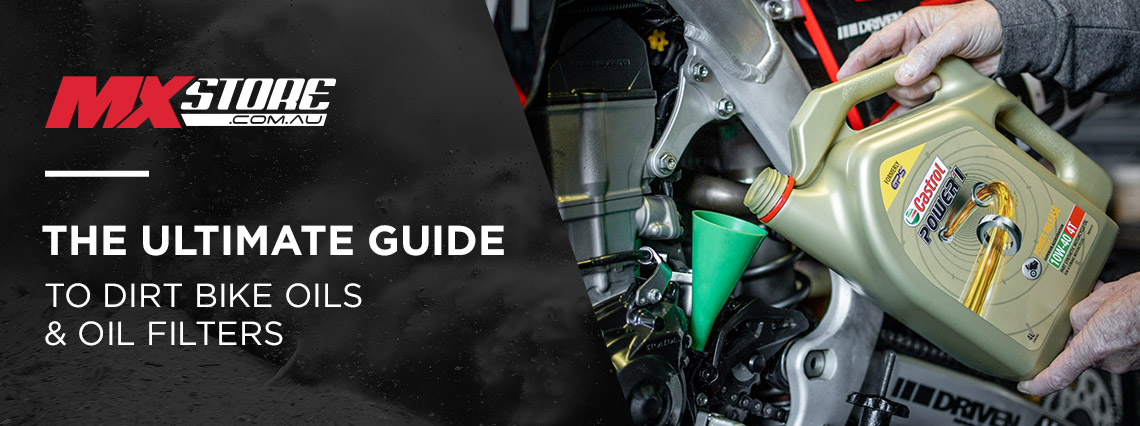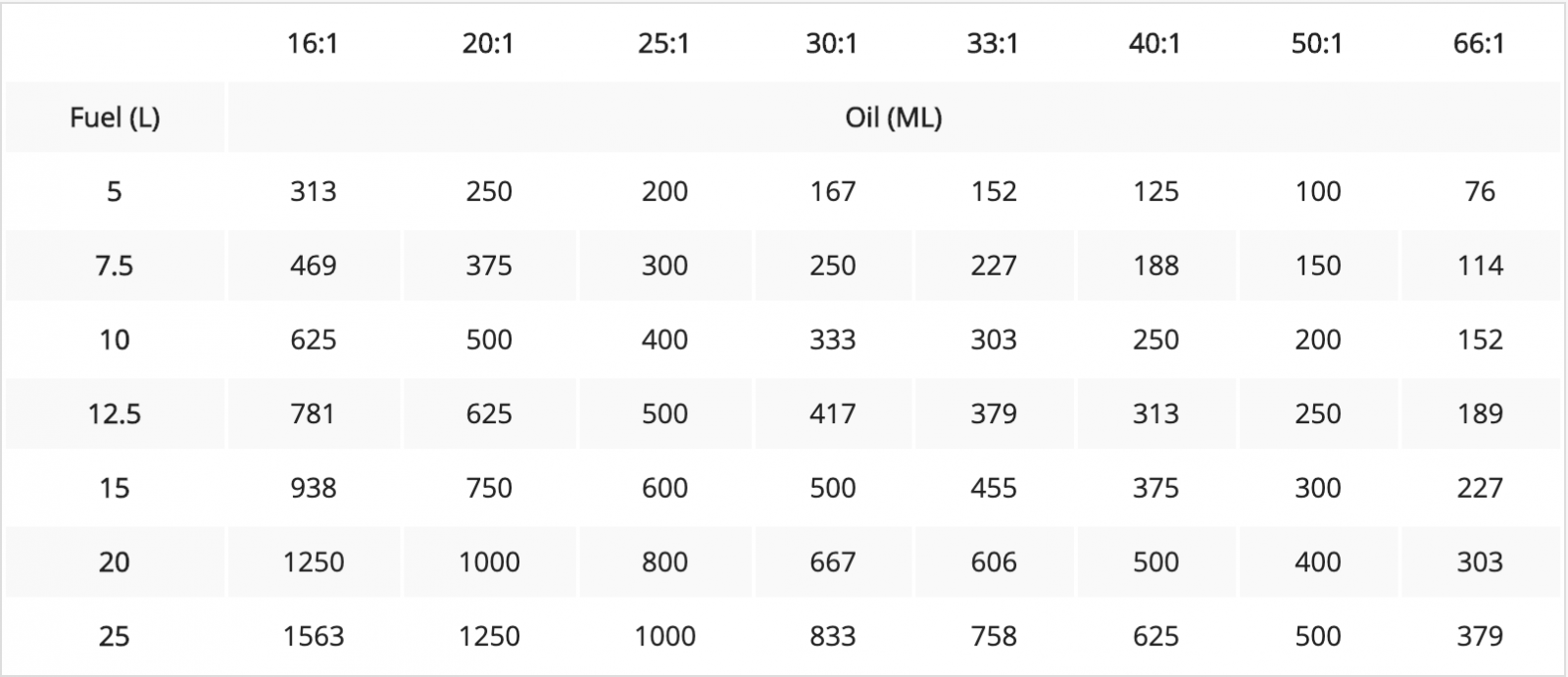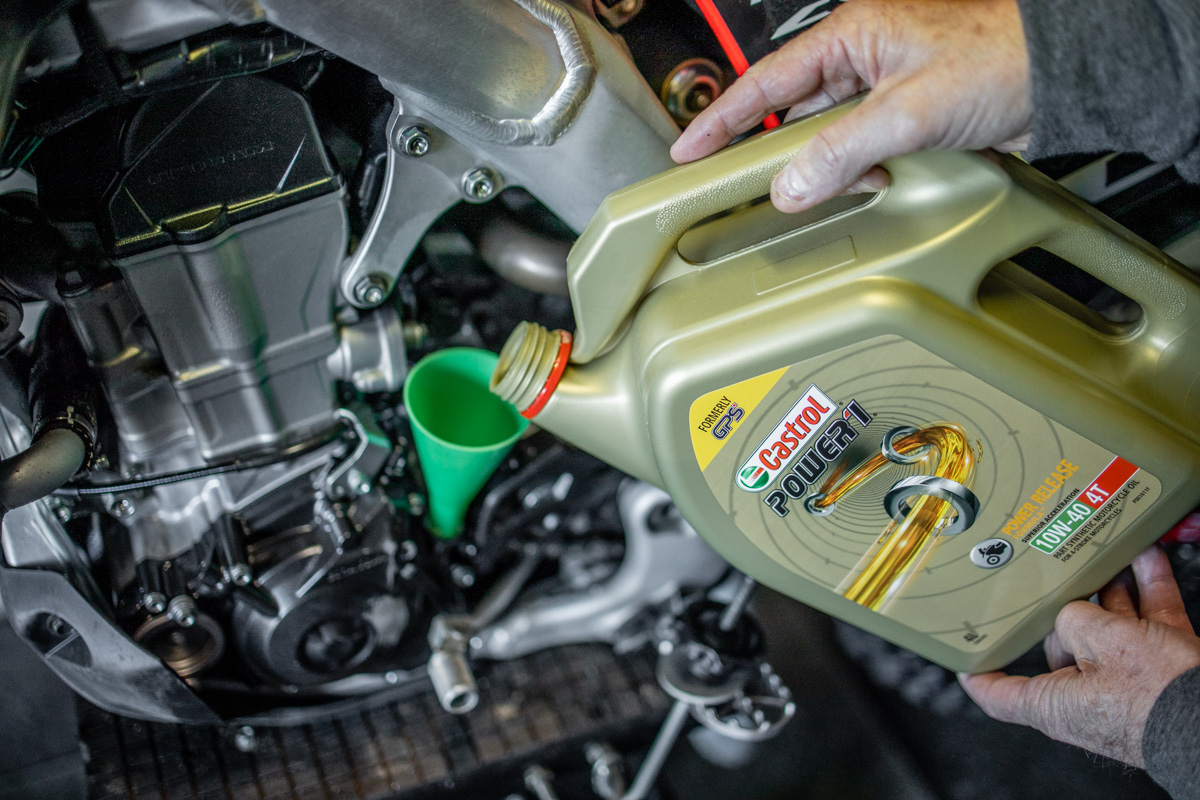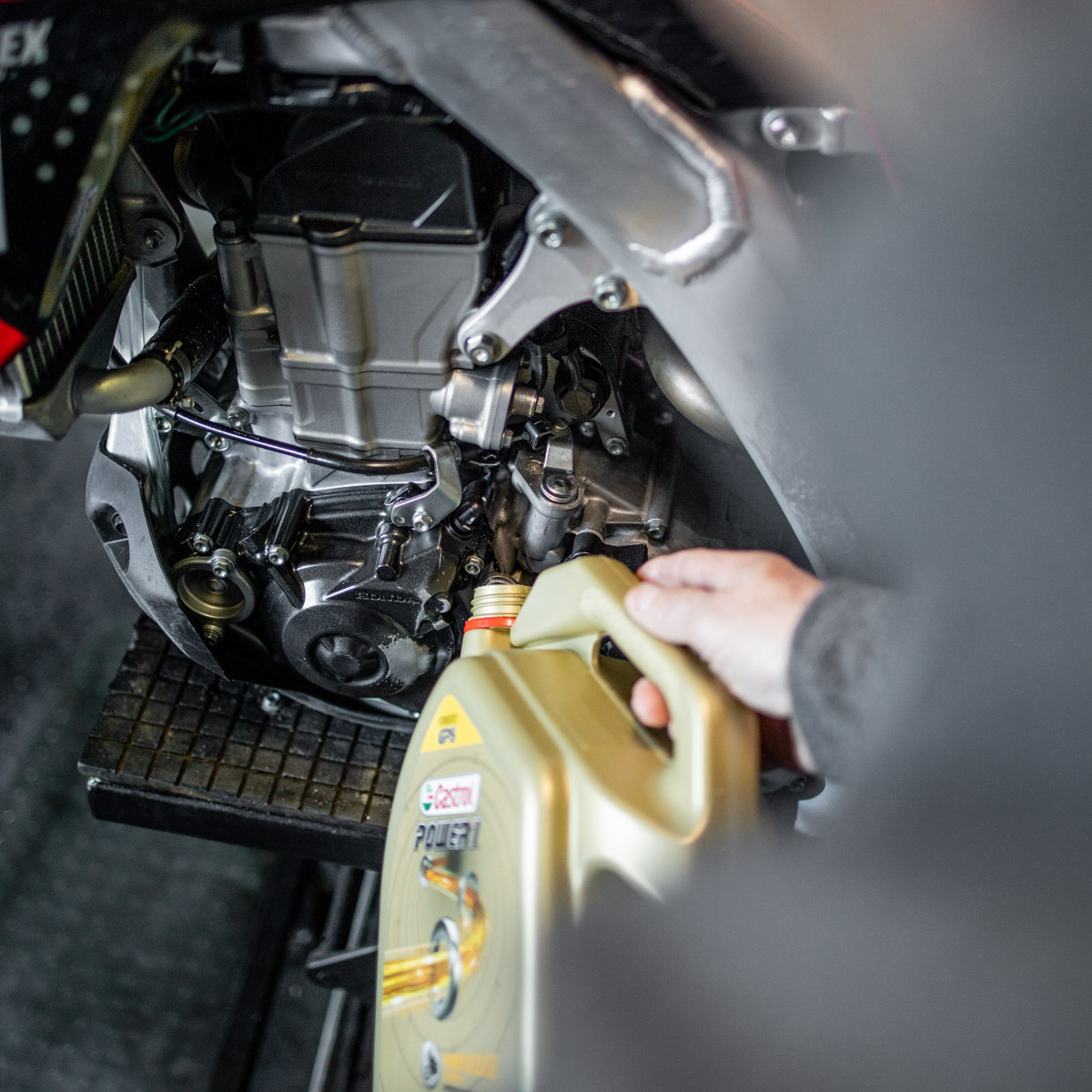What Oil To Use In Your Dirt Bike

 Dirt bike oil can be tricky business, and it's important to know when, how and what to put into your bike, as it's essentially the bloodline of your motorcycle. In this ultimate guide to dirt bike oil, we go through everything you need to know when it comes to changing your oil, from choosing the right viscosity all the way through to replacing your oil filter.
Dirt bike oil can be tricky business, and it's important to know when, how and what to put into your bike, as it's essentially the bloodline of your motorcycle. In this ultimate guide to dirt bike oil, we go through everything you need to know when it comes to changing your oil, from choosing the right viscosity all the way through to replacing your oil filter.
2-stroke oil Vs 4-stroke oil:
2-stroke oil and 4-stroke oil act in the same way in that they are designed to lubricate your engine, although how they work and what you do with them is completely different.
2-stroke oil generally comes in the form of pre-mix, and this is what you add to your fuel at a preferred ratio. 2-stroke pre-mix oil doesn't have weight or viscosity indications (which you'll learn about below).
4-stroke oil is poured directly into the engine and isn't mixed with fuel. 4-stroke oil is available in a number of different weights know as viscosity.
What oil should I be using in my 2-stroke motocross bike?
The older technology being a 2 stroke has a simple system which needs two types of oil to survive. One being Dirt Bike Gearbox Oil which is used to lubricate your bottom end bearings, clutch and transmission.
A decent motorcycle gear box oil designed for wet clutches will be around 80w which is a number to quantify the viscosity of the oil. Avoid using cheap oils or oil made for cars as the viscosity will not be the same and this may damage a motocross bikes high performance engine.
For the top end of your two-stroke motor being the piston, rings and top end bearings a different type of 2 stroke oil is added to the fuel at a certain ratio to act as lubrication which is burnt up upon combustion. Typical fuel/oil ratios in two-stroke racing machines are from 20:1 to 50:1 and everything in between.
Always check your owner’s manual to see what the recommended ratio and brand of oil is for your particular bike as too much or too little oil in your fuel can lead to engine damage or seizure!
How do I mix fuel and oil for my 2-stroke?
Mixing fuel and oil for your 2-stroke dirt bike is a really simple process, and it's a case of adding the right amount of oil for the amount of fuel you have.
First, you'll need to decide on what ratio of oil and fuel to be mixed, which comes down to how your bike is set-up and personal preference. Manufacturers will usually state a recommended fuel ratio in the owners manual, but a common ratio is 40:1 - a 40:1 ratio would look like this: If you put 10 litres of fuel in your fuel can, you would need to add 250ml of oil. You can refer to the chart below.
 Now there are two ways you can measure this - you can either use the measurement indicator on the side of the oil packaging, however this can sometimes not be as accurate if you're not careful, or you can use an oil measuring jug, which is what we recommend. When you're at the petrol station, you can use the bowser to measure how much fuel you've added to your fuel can.
Now there are two ways you can measure this - you can either use the measurement indicator on the side of the oil packaging, however this can sometimes not be as accurate if you're not careful, or you can use an oil measuring jug, which is what we recommend. When you're at the petrol station, you can use the bowser to measure how much fuel you've added to your fuel can.
Finally, it's a case of making sure your fuel hug is secured shut, and mixing the fuel and oil around.
What oil should I be using in my 4-stroke motocross bike?
Most modern-day four-strokes on the market use the same motor oil to lubricate everything from the valves, cam, piston, crank, clutch and transmission. This 'all in one' oil system forces the motor oil to lubricate more than twice the amount of moving parts as the traditional independent premix and gearbox oil of a two-stroke machine.
Four-stroke oil for racing motors has been engineered in a way to produce maximum power from a lightweight and simple engine casing. The engine has been streamlined so much so that a motocross engine uses just enough oil to get the job done and nothing more. On a racing machine it is crucial you have a routine maintenance schedule which is assisted by an hour meter to ensure your engine is protected. Four-stroke machines also have Dirt Bike Oil Filters which should be replaced whenever you change your oil.
If you struggle with making a mess while changing your bike oil, using a handy product called Racetech Oil Catcher can reduce the mess and make life easier.

Why do some bikes have separate oil compartments?
Separate oil: The advantages of separating the oil, like older Honda 4-stroke models, is that the top-end is not contaminated by clutch debris or broken teeth. Also the heat of the combustion side of the engine does not thin out the oil which is designed for your transmission and clutch. The oil in each compartment has different qualities and is designed specifically for each application.
The downside of having two smaller oil chambers is increasing the need for more frequent oil changes and even a small loss of oil can be disastrous when there is only a small supply of oil to begin with.
Shared oil: The benefit of using the same oil throughout the engine is that the large supply is less likely to run low and reach critical levels. With the larger oil supply, overall engine temperatures are reduced and oil changes are not needed as often.
What is viscosity?
Viscosity is a word you're going to see a lot when it comes to 4-stroke oil, and it's something to get your head around before ordering the oil for your next 4-stroke service. Viscosity is the thickness or weight of your oil at temperature - you might be familiar with seeing numbers on the packaging of your oil such as 10W40 or 20W50. These numbers determine how easy the oil flows at low and high operating temperatures.
A popular viscosity oil is 10W40, which will flow better than a 10W50 oil at high operating temperatures.
Engine oils usually thicken when they cool and get thinner as they are heated. A low viscosity oil will flow easier to protect engine parts at cold temperatures, while a high viscosity oil will generally be better at maintaining film strength to protect engines at high temperatures.
The owner's manual of your motocross or off-road bike will always have a recommended oil weight by the manufacturer, and we always advise you to follow this unless you have a strong understanding of motorcycle oil and how it can change the characteristics of your dirt bike. Synthetic oil or semi-synthetic oil is also recommended for modern dirt bike engines.
Can I use car oil in my dirt bike?
Absolutely not. Car or automotive oil is often cheaper than motorcycle oil, and will sometimes offer the same viscosities, which leads some riders to think they can use it rather than a motorcycle-specific oil.
Car oil is designed for, well, cars! It's made for the workings of a car engine and its type of use - which is generally thousands of kilometres of easy driving.
A dirt bike has a performance engine and is generally always under significant load. Motorcycle oil is designed to cater for this, ensuring the engine and its moving parts are lubricating and operating correctly in such conditions.
Using car oil can lead to serious and costly engine problems. Motorcycle oil is always the best oil for your dirt bike.
How to check your motor oil level:
Checking the oil level on your dirt bike is a super simple process, and it starts by getting your engine warm. The reason you want to start your bike and get the engine warm is so the oil is distributed around the motor for a more accurate reading.
Most dirt bikes will have an inspection window on the engine, which is usually down low. Here you'll see two markings - if the oil is above the top marking, you need to drop some oil, and if it's below the bottom one, you need to top your engine up.
Some dirt bike manufacturers, such as Honda, actually come fitted with a dipstick fitted to the oil filler cap. The same process applies in starting your engine and getting it warm. Once you've turned it off, you can unscrew the oil filler cap and wipe it clean. Re-install the cap/dipstick, and restart the bike. Once it's warm again, hit the killswitch and unscrew the cap/dipstick. If it's below the markings, you need more oil, if it's above the markings, you have too much oil and will need to dump some.
Remember to check the level again after this process to ensure it's correct.
How to change your 4-stroke dirt bike oil:
In a 4-stroke engine, manufacturers will recommend the amount of oil your engine requires, both for just an oil change, but also for an oil change and oil filter replacement. It's best to use an oil measuring jug which allows you to get the exact amount you need, although you can always check the oil level and adjust from there.
After you've 'dumped' the old oil, it's time to fill up your engine with the new oil - it's simply a case of unscrewing the oil filler cap and pouring the oil in. If you're not using an oil measuring jug, then we recommend using a funnel to save any mess or wasting oil.

When should you change your dirt bike oil:
Frequently changing your dirt bike oil is important to not only extend the life of your engine and maintain its high-performance, but to also inspect the oil of any metal shavings that could indicate engine damage.
Oil changes come down to the type of riding your doing, what you can afford, and how much riding you're doing.
If you're a serious racer and can afford it, we always recommend changing your oil after every outing. This ensures your engine is well maintained and performing as it should, while it also provides a frequent opportunity to inspect the oil coming out.
In all other cases, we recommend changing your dirt bike oil every four to five hours.
When to change oil filter:
If you're changing your oil every four to five hours, we also recommend changing your oil filter at the same time. This a regular interval that will ensure your engine is running as well as it can. It's also a good practice to replace the 'crush' washer on the sump bolt, which is a cheap replacement and gives you extra peace of mind. You can read our complete guide on when you should change your oil here: How Often Should You Change Dirt Bike Oil
How to change a dirt bike oil filter:
Changing your dirt bike oil filter is another simple and easy process. Refer to your owner's manual on the exact location of your oil filter, although most bikes will have a cap on the left-hand side of the engine, which is secured by two or more bolts.
Simply remove the bolts and cap, take out the old filter, and install the new one. Always check that the filter has been installed the right way and that the oil filter cover is clean.
My bike is leaking oil, what should I do?
Oil leaks can be the result of poor maintenance, although parts such as seals and gaskets wear over time, and this is usually where oil leaks originate from. If you're not confident with your mechanical skills, it's best to take your bike to a mechanic, but if you can identify where the leak is coming from and if you are confident in your mechanical skills, fixing the leak can just be a case of replacing a seal or gasket. If the leak persists, it could be more serious and needs further inspection by a qualified mechanic.
Other oils you need to know about:
Dirt bikes also use oils other than motorcycle engine oil, such as gearbox or transmission oil, which is most commonly used in 2-strokes, and there's also air filter oil. Again, your owners manual will have a recommendation on which gear oil and weight are best for your dirt bike.
When it comes to air filter oil, there is a range of different brands with really good offerings, including Motorex, Maxima, Motul, and BelRay. Each brand has its own formula, although most offer the same protection when it comes to keeping dirt out of your air filter and engine.














